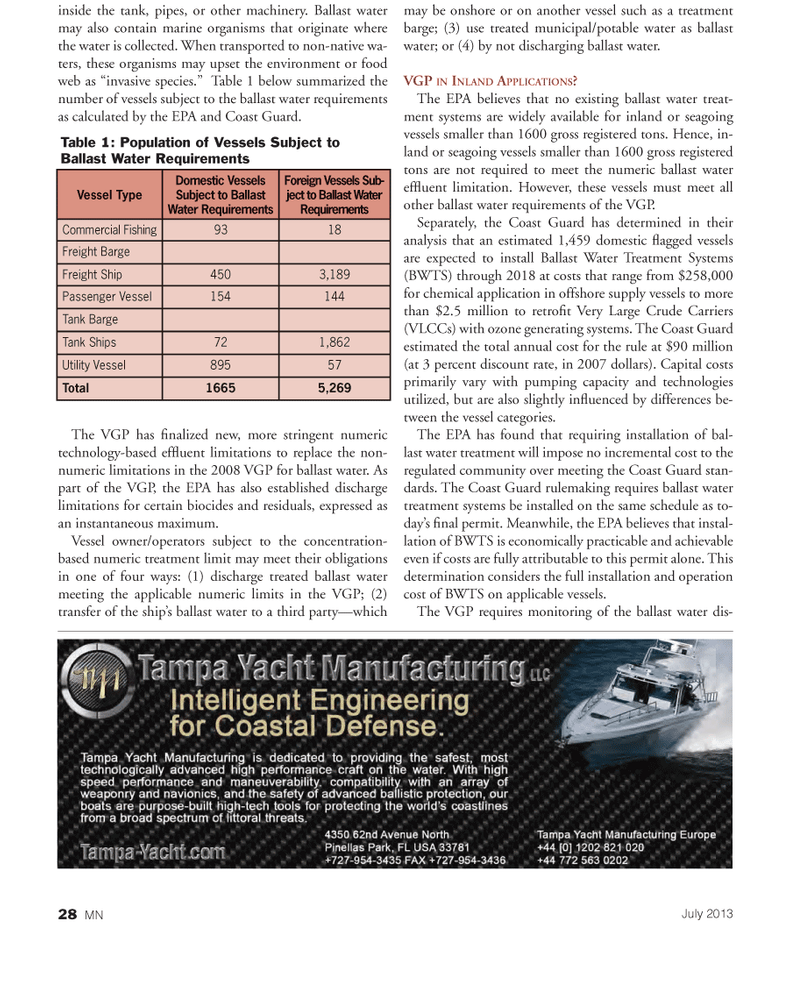
Page 28: of Marine News Magazine (July 2013)
Propulsion Technology
Read this page in Pdf, Flash or Html5 edition of July 2013 Marine News Magazine
inside the tank, pipes, or other machinery. Ballast water may also contain marine organisms that originate where the water is collected. When transported to non-native wa- ters, these organisms may upset the environment or food web as invasive species.? Table 1 below summarized the number of vessels subject to the ballast water requirements as calculated by the EPA and Coast Guard. The VGP has ? nalized new, more stringent numeric technology-based ef? uent limitations to replace the non- numeric limitations in the 2008 VGP for ballast water. As part of the VGP, the EPA has also established discharge limitations for certain biocides and residuals, expressed as an instantaneous maximum.Vessel owner/operators subject to the concentration- based numeric treatment limit may meet their obligations in one of four ways: (1) discharge treated ballast water meeting the applicable numeric limits in the VGP; (2) transfer of the ships ballast water to a third party?which may be onshore or on another vessel such as a treatment barge; (3) use treated municipal/potable water as ballast water; or (4) by not discharging ballast water. VGP IN INLAND APPLICATIONS ?The EPA believes that no existing ballast water treat- ment systems are widely available for inland or seagoing vessels smaller than 1600 gross registered tons. Hence, in- land or seagoing vessels smaller than 1600 gross registered tons are not required to meet the numeric ballast water ef? uent limitation. However, these vessels must meet all other ballast water requirements of the VGP. Separately, the Coast Guard has determined in their analysis that an estimated 1,459 domestic ? agged vessels are expected to install Ballast Water Treatment Systems (BWTS) through 2018 at costs that range from $258,000 for chemical application in offshore supply vessels to more than $2.5 million to retro? t Very Large Crude Carriers (VLCCs) with ozone generating systems. The Coast Guard estimated the total annual cost for the rule at $90 million (at 3 percent discount rate, in 2007 dollars). Capital costs primarily vary with pumping capacity and technologies utilized, but are also slightly in? uenced by differences be- tween the vessel categories. The EPA has found that requiring installation of bal- last water treatment will impose no incremental cost to the regulated community over meeting the Coast Guard stan- dards. The Coast Guard rulemaking requires ballast water treatment systems be installed on the same schedule as to- days ? nal permit. Meanwhile, the EPA believes that instal- lation of BWTS is economically practicable and achievable even if costs are fully attributable to this permit alone. This determination considers the full installation and operation cost of BWTS on applicable vessels. The VGP requires monitoring of the ballast water dis- Vessel Type Domestic Vessels Subject to Ballast Water Requirements Foreign Vessels Sub- ject to Ballast Water Requirements Commercial Fishing9318 Freight Barge Freight Ship4503,189 Passenger Vessel154144 Tank Barge Tank Ships721,862 Utility Vessel89557 Total16655,269 Table 1: Population of Vessels Subject to Ballast Water Requirements July 201328 MNMN July2013 Layout 18-31.indd 286/27/2013 1:02:33 PM

 27
27

 29
29
